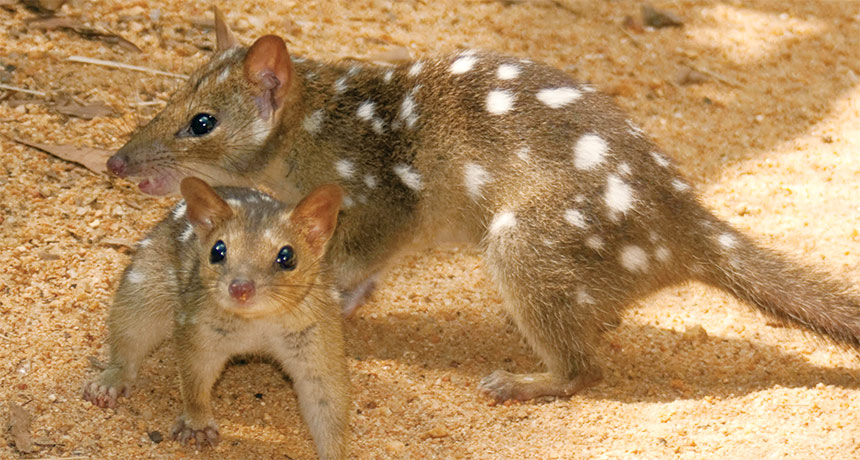Introduction
Quolls, small carnivorous marsupials native to Australia and New Guinea, exhibit fascinating behaviors regarding sleep patterns and reproductive strategies. Despite their diminutive size, quolls display remarkable endurance and adaptability in their natural habitats. However, their lifestyle choices, particularly concerning sleep and mating behaviors, often lead to intriguing outcomes, including sleep deprivation and reproductive expenditure.
Sleep Patterns in Quolls
Quolls are primarily nocturnal creatures, hunting and foraging during the night and resting during the day. However, their sleep patterns are not as straightforward as those of other nocturnal animals. Studies have shown that quolls often engage in polyphasic sleep, characterized by multiple short sleep bouts throughout the day and night. This fragmented sleep pattern allows them to remain vigilant to potential threats while still obtaining the rest they need to function effectively.
Interestingly, quolls have been observed to sacrifice sleep during periods of high activity, such as when resources are scarce or during the mating season. This behavior can lead to sleep deprivation, which may have various consequences on their health and behavior.
Sleep Deprivation in Quolls
While the exact effects of sleep deprivation on quolls are not fully understood, research suggests that it can negatively impact their cognitive abilities, immune function, and overall well-being. Sleep-deprived quolls may exhibit altered behavior, reduced motor skills, and increased susceptibility to diseases and predators.
Furthermore, chronic sleep deprivation can lead to long-term health issues, including impaired reproductive success and decreased lifespan. Quolls deprived of adequate sleep may struggle to maintain optimal body condition, making them less competitive in mating and resource acquisition.
Mating Behaviors and Reproductive Expenditure
Mating in quolls is a highly energetically demanding activity, particularly for males. During the breeding season, male quolls engage in intense competition for mates, often engaging in aggressive encounters with rival males. Additionally, male quolls invest significant energy in scent marking and vocalizations to attract females and establish dominance within their territories.
Female quolls, on the other hand, undergo a complex reproductive process that includes estrus, copulation, gestation, and lactation. The timing and duration of these reproductive phases vary depending on factors such as environmental conditions and resource availability.
Reproductive Strategies of Quolls
Quolls employ various reproductive strategies to maximize their reproductive success in dynamic environments. These strategies often involve trade-offs between current and future reproductive potential, as well as between parental care and personal survival.
One such strategy observed in quolls is semelparity, or "mating to death." In some cases, particularly when resources are abundant and competition for mates is intense, male quolls may allocate all their energy and resources towards mating efforts, neglecting their own health and survival in the process. This extreme reproductive expenditure can lead to exhaustion, malnutrition, and ultimately death.
Ecological Significance and Conservation Implications
The mating behaviors and reproductive strategies of quolls have significant ecological and conservation implications. Understanding the factors influencing quoll population dynamics, including sleep patterns, mating behaviors, and reproductive expenditure, is crucial for effective conservation management strategies.
Habitat loss, fragmentation, and introduced predators pose significant threats to quoll populations across their range. Moreover, climate change and altered fire regimes further exacerbate these challenges, potentially disrupting quoll breeding cycles and reproductive success.
Conservation efforts aimed at protecting quoll populations must consider the complex interactions between sleep ecology, mating behaviors, and reproductive strategies. By addressing key threats to quoll habitats and implementing targeted conservation interventions, such as habitat restoration, predator control, and captive breeding programs, we can help ensure the long-term survival of these charismatic marsupials.
Conclusion
Quolls exhibit fascinating behaviors regarding sleep patterns and reproductive strategies. Their ability to adapt to changing environmental conditions, coupled with their unique mating behaviors and reproductive strategies, makes them intriguing subjects for scientific study and conservation efforts.
By unraveling the complexities of quoll ecology and behavior, we can gain valuable insights into the broader dynamics of ecosystem function and resilience. Through collaborative research and conservation initiatives, we can work towards safeguarding quoll populations for future generations to enjoy and appreciate.


